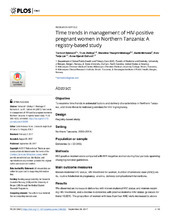| dc.contributor.author | Rebnord, Tormod | en_US |
| dc.contributor.author | Østbye, Truls | en_US |
| dc.contributor.author | Mmbaga, Blandina Theophil | en_US |
| dc.contributor.author | Mchome, Bariki | en_US |
| dc.contributor.author | Lie, Rolv T. | en_US |
| dc.contributor.author | Daltveit, Anne Kjersti | en_US |
| dc.date.accessioned | 2018-03-16T14:19:19Z | |
| dc.date.available | 2018-03-16T14:19:19Z | |
| dc.date.issued | 2017-09-28 | |
| dc.Published | Rebnord T, Østbye T, Mmbaga BT, Mchome, Lie RT, Daltveit AK. Time trends in management of HIV-positive pregnant women in Northern Tanzania: A registry-based study. PLoS ONE. 2017;12(9):e0184362 | eng |
| dc.identifier.issn | 1932-6203 | |
| dc.identifier.uri | https://hdl.handle.net/1956/17527 | |
| dc.description.abstract | Objective: To examine time trends in antenatal factors and delivery characteristics in Northern Tanzania, and relate these to national guidelines for HIV in pregnancy. Design: Registry-based study. Setting: Northern Tanzania, 2000–2014. Population or sample: Deliveries (n = 33 346). Methods: HIV-positive women were compared with HIV-negative women during four periods spanning changing national guidelines. Main outcome measures: Known maternal HIV status, HIV treatment for woman, number of antenatal care (ANC) visits, routine folate/iron in pregnancy, anemia, delivery complications/interventions. Results: We observed an increase in deliveries with known maternal HIV status and women receiving HIV treatment, and a decline in deliveries with positive maternal HIV status (p-values for trend <0.001). The proportion of women with less than four ANC visits increased to above 30 percent irrespective of HIV status. Use of routine folate/iron increased, corresponding to a decrease in anemia which was strongest in HIV-negative women. Incidence of elective caesarean section (CS) and emergency CS remained unchanged for HIV-positive women (7.1% and 25.5%, respectively, in the last period). Use of invasive procedures declined in both groups of women. Mothers who were young, single, had low education, high parity or lived in the rural area more often had indicators of poor antenatal care. Conclusions: Increasing adherence to national guidelines over time was found for most selected outcomes. Still, a high occurrence of insufficient ANC, anemia and emergency CS call for efforts to explore and identify barriers that hinder optimal care. | en_US |
| dc.language.iso | eng | eng |
| dc.publisher | PLOS | eng |
| dc.relation.uri | http://journals.plos.org/plosone/article/file?id=10.1371/journal.pone.0184362&type=printable | |
| dc.rights | Attribution CC BY | eng |
| dc.rights.uri | http://creativecommons.org/licenses/by/4.0 | eng |
| dc.title | Time trends in management of HIV-positive pregnant women in Northern Tanzania: A registry-based study | en_US |
| dc.type | Peer reviewed | |
| dc.type | Journal article | |
| dc.date.updated | 2018-02-08T14:02:01Z | |
| dc.description.version | publishedVersion | en_US |
| dc.rights.holder | Copyright 2017 The Author(s) | |
| dc.identifier.doi | https://doi.org/10.1371/journal.pone.0184362 | |
| dc.identifier.cristin | 1508043 | |
| dc.source.journal | PLoS ONE | |

